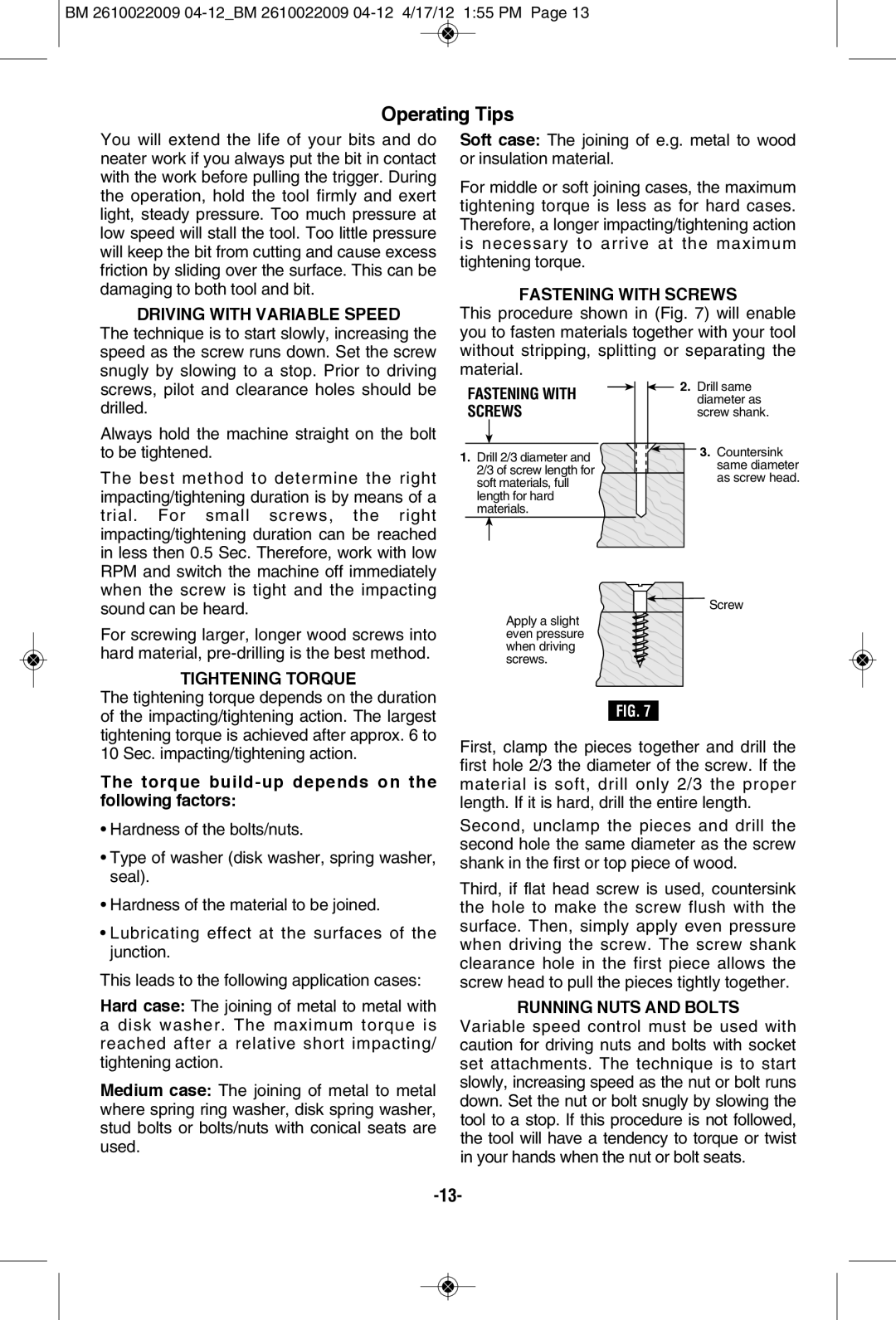
BM 2610022009
Operating Tips
You will extend the life of your bits and do neater work if you always put the bit in contact with the work before pulling the trigger. During the oper ation, hold the tool firmly and exert light, steady pressure. Too much pressure at low speed will stall the tool. Too little pressure will keep the bit from cutting and cause excess friction by sliding over the surface. This can be damaging to both tool and bit.
DRIVING WITH VARIABLE SPEED
The technique is to start slowly, increasing the speed as the screw runs down. Set the screw snug yl by slowing to a stop. Prior to driving
Soft case: The joining of e.g. metal to wood or insulation material.
For middle or soft joining cases, the maximum tightening torque is less as for hard cases. Therefore, a longer impacting/tightening action is necessary to arrive at the maximum tightening torque.
FASTENING WITH SCREWS
This procedure shown in (Fig. 7) will enable you to fasten ma erialst together with your tool without stripping, splitting or separating the material.
screws, pilot and clearance holes should be drilled.
Always hold the machine straight on the bolt to be tightened.
The best method to determine the right impacting/tightening duration is by means of a trial. For small screws, the right impacting/tightening duration can be reached in less then 0.5 Sec. Therefore, work with low RPM and switch the machine off immediately when the screw is tight and the impacting sound can be heard.
For screwing larger, longer wood screws into hard material,
TIGHTENING TORqUE
FASTENING WITH
SCREWS
1. Drill 2/3 diameter and ![]() 2/3 of screw length for soft materials, full
2/3 of screw length for soft materials, full
length for hard materials.
Apply a slight even pressure when driving screws.
![]() 2. Drill same diameter as screw shank.
2. Drill same diameter as screw shank.
![]() 3. Countersink same diameter as screw head.
3. Countersink same diameter as screw head.
Screw
The tightening torque depends on the duration of the impacting/tightening action. The largest tightening torque is achieved after approx. 6 to 10 Sec. impacting/tightening action.
The torque build-up depends on the following factors:
•Hardness of the bolts/nuts.
•Type of washer (disk washer, spring washer, seal).
•Hardness of the material to be joined.
•Lubricating effect at the surfaces of the junction.
This leads to the following application cases:
Hard case: The joining of metal to metal with a disk washer. The maximum torque is reached after a relative short impacting/ tightening action.
Medium case: The joining of metal to metal where spring ring washer, disk spring washer, stud bolts or bolts/nuts with conical seats are used.
FIG. 7
First, clamp the pieces together and drill the first hole 2/3 the diam eter of the screw. If the material is soft, drill only 2/3 the proper length. If it is hard, drill the entire length.
Second, unclamp the pieces and drill the second hole the same diameter as the screw shank in the first or top piece of wood.
Third, if flat head screw is used, countersink the hole to make the screw flush with the surface. Then, simply apply even pressure when driving the screw. The screw shank clearance hole in the first piece allows the screw head to pull the pieces tightly together.
RUNNING NUTS AND BOLTS
Variable speed control must be used with caution for driving nuts and bolts with socket set attach ments. The technique is to start slowly, increasing speed as the nut or bolt runs down. Set the nut or bolt snugly by slowing the tool to a stop. If this procedure is not followed, the tool will have a tendency to torque or twist in your hands when the nut or bolt seats.
